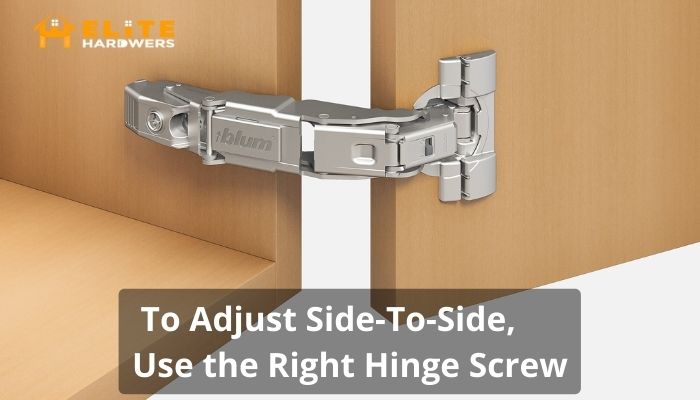How To Make A Blum Hinge Adjustment?
As most people already know, Blum’s hinges make some of the best on the market. But they’re often tricky to adjust and tweak to make it just right for a specific door frame. With three-axis adjustment capabilities for height, depth, and side-to-side, most beginner DIY woodworkers find it challenging to adjust this door hinge.
So what’s the best way to approach a Blum hinge adjustment?

A bit of patience and a Phillips head screwdriver is all that’s required. A Blum hinge can be easily adjusted just by tweaking the tightness of its three screw sets — the front side, the left screw, and the right screw.
In this post, we’ll walk through the process and help fix those squeaky doorframes. Let’s start.
How To Adjust Blum Hinges
Blum hinges are adjustable on three axis — by height, depth, and side-to-side. Let’s go over the individual processes.
Prerequisites: A Phillips Head Screwdriver is all you need.
Height Adjustment
The first adjustment we’ll be going over is height adjustment. To adjust the height, the top and bottom set of screws need to be loosened. You’ll find these screws on the top and bottom sides of the clip, respectively.

To make the adjustment, take the Phillips head screwdriver and unscrew it counter-clockwise to loosen it up. Initially, unscrew a good amount and get the clip super loose.
Then, move the hinge up or down with your hands until it’s placed at your desired height. Once done, start by screwing in the bottom screw of the clip halfway and then the top screw halfway. After that, tighten both screws, and the hinge should be properly working.
Depth Adjustment
Depth adjustment is needed when you want to tweak the alignment of the door with respect to the cabinet or neighboring door frames. To make this adjustment, unscrew the left-most screw on the Blum hinge. Don’t loosen it too much this time, only so much so you can now manually push or pull on it.

After you’ve ensured that, physically apply pressure to the door frame and align it with the neighboring door frames or cabinet. You might need to measure cabinet door hinge to complete this step properly.
Once you’ve reached your desired alignment, tighten the screw back in place and check for squeaky noises. If found, loosen the screw just a bit.
Side to Side Adjustment
A common question we get is: how to fix soft close cabinet hinges, and getting the side-to-side adjustment right can aid in that process.

For side-to-side adjustment, we use the rightmost screw on the hinge. This screw should be turned either clockwise or anticlockwise, depending on the direction you want the door to be moved. The direction depends on what orientation of hinge is being used —
Left-Sided Hinges
For left-aligned hinges, go clockwise to move it to the left direction. On the contrary, anticlockwise moves it to the right.
Right Sided Hinges
These accept the opposite. Turn clockwise to move to make a right-side adjustment. And finally, move counterclockwise to make a left-side adjustment.
Frequently Asked Questions
Can I use a Blum hinge on a frameless door with only a face frame?
Yes. Some Blum hinges are made specifically for face frames. But even if it’s not a special type, you can use a regular one on the face frame. Of most hinge types, only the mounting plate differs.
How do I know which angle my door frame opens?
Door frames with hinges usually move at three different angles — 100 degrees, 125 degrees, and 165 degrees. There’s an easy rule of thumb to differentiate between them.
If the door opens perpendicularly, it’s 100 degrees. And when the door opens all the way, it’s 165 degrees. Anywhere in between is 125 degrees.
How to know if my Blum hinge is free to swing or self-closing?
Most Blum hinges are self-closing — there’s a spring in place which assists you in closing the door. If you think your door frame lacks a spring mechanism, it’s probably free swing. Another key takeaway for free swing hinges is that they have magnets in place.
Can I apply a Blum hinge to my door frame?
This depends on the door thickness. Most hinges can be applied if the door thickness is 3/4″ or 5/8″. Don’t worry too much about this, as almost all doors fit into this category. Only for the special one and a-quarter inch and 7/8″ thickness doors do you need a special type of Blum hinge.
How many Blum hinges do I need?
In most cases, you won’t need more than two. For doors around 40 inches high and around 25 inches wide, two will suffice. For others, you should fit three and above depending on the special case.
Conclusion
If you’re here at the end, we hope you’ve successfully adjusted your Blum hinge, and your door frame is in line with the cabinet. Although Blum hinges are sometimes challenging with their three-axis adjustment capabilities, as you’ve seen in this post, it’s fairly simple.
As a final note, we’d recommend playing around with the screw types if you need to make further adjustments. A Phillips head screwdriver and some time to make tweaks are all you need for Blum hinges. Once you get it right, tighten it up and the Blum hinge should last you for the entirety of your cabinet’s lifespan. Cheers!




